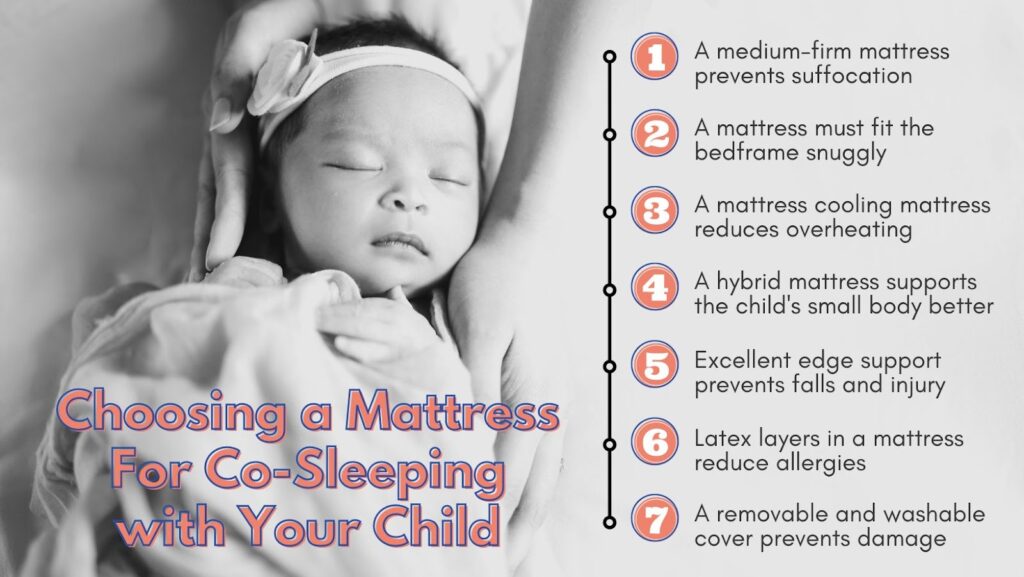Co-sleeping with a child, like choosing a suitable mattress, is a uniquely personal and individual choice that a parent might make for many reasons. More often than not, co-sleeping is a temporary practice that will change as the child grows. But there are instances where co-sleeping may be a prolonged situation, and the mattress you choose will help ensure both the child and parent sleep soundly and safely.
Some circumstances that warrant extended co-sleeping arrangements are illness, developmental delays, emotional distress, post-surgery care, or feeding difficulties. The child’s age and any special medical conditions will influence how long the child co-sleeps with the parents and the type of mattress chosen. Whatever your unique co-sleeping situation, this article will help you choose a mattress that maximizes your and your child’s comfort and prevents any injuries or accidents.

Use the Best Mattress with a Medium-Firm Surface To Prevent Suffocation
One of the most important things to consider when buying a mattress that will be used for prolonged or continuous co-sleeping with your child is the materials that are used in the mattress’s production. You’ll need a mattress with several supportive and responsive layers consisting of memory foam and other foam or coil composites. But it is essential that soft memory foam not be the upper-most layer in the mattress.
Memory foam is very form-conforming, making it very comfortable to sleep on as it molds to the body. This contouring feature increases with the softness of the foam, which can make it difficult for a small child or baby to change positions or move their mouth and nose away from the surface, increasing the chances of them suffocating.
So selecting a mattress with a firm or medium-firm top layer is safer for co-sleeping with a child. You should choose one of the best mattresses in Canada, which has a supportive top layer, that you can check out on Comfynorth.ca. These types of mattresses offer the best support because of their firmness levels and ability to adapt to any body type. This also ensures the child is not accidentally smothered in soft exterior layers.
Ensure the Mattress Fits the Bedframe Snuggly To Prevent the Child From Being Trapped
A mattress must always be the size of the frame. A mattress that is too small for the frame will shift at night and may trap the child or crush them. Conversely, a mattress that is too big for the frame will be unstable and cause the child to fall off the bed and get badly injured.
You should make sure the top of your mattress is flush with the headboard and that there are no gaps that the child’s arm or leg could get stuck in. It is also essential that all bedding, like mattress toppers (if you’re using one) and fitted sheets, are securely fixed to the bed to prevent suffocation or entanglement.
The mattress and bedding must be the appropriate size for the bedframe.
Choose a Mattress with Cooling Features To Prevent the Child From Over-Heating
If your child is co-sleeping for medical reasons, then maintaining a comfortable temperature on the bed surface is paramount to ensure a speedy recovery. Keeping a sick child’s temperature down reduces the chances of seizures and disrupted sleep disorders. There is also new research about dry herb vaporizers in pediatric care that assist with better sleep and recovery in children who struggle with health issues that can be used in conjunction with co-sleeping habits.
Cool mattresses ensure the child doesn’t overheat.
Use a Hybrid Mattress With Zoned Support To Support the Child’s Smaller Body
The weight difference between an adult and a small child is usually quite large, making it difficult to choose a mattress that can accommodate both. Fortunately, mattress manufacturers have been radically improving their designs recently, and we now have mattresses with zoned support.
These specialized zones can provide the right responsiveness level across the mattress surface because they consist of different layers of mattress materials supported by a based layer of individually wrapped coils. We call them hybrid mattresses because they mimic traditional mattresses but respond like memory foam—making them ideal for many body types and sizes.

Choose a Mattress With Excellent Edge Support To Prevent the Child From Falling Off the Bed
Parents who are new to co-sleeping may not know that placing the child between the parents is not ideal because this can cause the child to overheat or be accidentally smothered. This is why it is recommended that the child sleep on the mother’s side of the bed, especially if breastfeeding. The best practice when co-sleeping in this way is to have a specially designed side rail that is safe for children and won’t trap them but will prevent them from rolling off the bed.
Many new mothers purchase side-opening bassinets that fix to the side of the bed to ensure easy access to the baby when feeding and allow moms to shift the baby back into the bassinet. Whatever your sleeping arrangements, good edge support is essential to keep the child safe during the night.
Buy a Mattress With Latex Layers to Reduce Allergies
Latex is a natural material that is manufactured using extracts from rubber trees. This means it naturally repels dust mites, dust, and other allergens, giving the mattress better breathability. Latex is also hypo-allergenic because it doesn’t contain any harsh chemicals or synthetic materials that could irritate the skin—this is especially useful if the child has asthma, allergic rhinitis, or other medical conditions that artificial substances might aggravate.
Natural mattress materials like latex, cotton, wool, and bamboo reduce childhood allergies.
Mattress Materials that Reduce Allergies
| Hypo-Allergenic Mattress Materials | Benefits and Features | How It’s Used in Mattress Construction |
|---|---|---|
| Latex | Naturally cool and breathable, so it limits dust mites | Used as a supportive layer to assist with buoyancy and support. |
| Cotton | Soft and breathable natural fiber that prevents mold | Used as a covering comfort layer that is breathable and cool |
| Wool | Has antimicrobial, antibacterial, and anti-fungal properties | Used as one of the top layers to make a mattress feel plush |
| Bamboo | Is naturally hypoallergenic, antibacterial, and anti-fungal, while also having moisture-wicking properties. | Used as an eco-friendly outer covering to protect the mattress layers |
Select a Mattress With a Removable and Washable Cover
When co-sleeping with a child, you run the risk of spills and accidents that could seep into the mattress’s layers and ruin the whole mattress. A child might accidentally wet the bed or leave an unfinished bottle on the mattress that leaks into the fibers. Having a removable cover means you can quickly and easily unzip it and pop it into the washing machine so it is ready for the next night.
We also recommend placing a waterproof cover on the mattress for an extra layer of protection. This will prolong the mattress’s lifespan and add a little extra plush comfort to its surface without making it bulky.
Conclusion
Co-sleeping has been proven to have developmental and psychological benefits for children who struggle with illness or emotional issues. Choosing the right mattress ensures the co-sleeping experience is safe and enjoyable for parents and children. A mattress for co-sleeping should have the following essential features to ensure the child is safe:
- A medium-firm surface to prevent suffocation
- Fit the bedframe securely to prevent trapping the child’s limbs, head, or torso
- Cooling features to prevent overheating.
- Zoned support to support the child’s lighter weight and smaller body.
- High-quality construction with edge support
- Allergy-reducing materials like latex and cotton
- A removable cover that can be easily washed in the case of accidents
